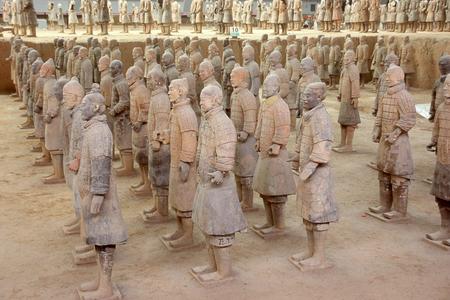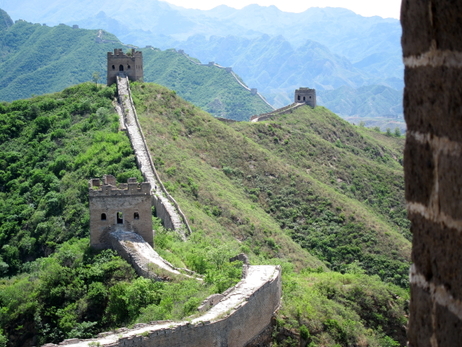Xi'an warriors -The terracotta Army

I guerrieri di terracotta dell’imperatore Qin Shi Huangdi
I guerrieri di terracotta furono scoperti casualmente da alcuni contadini che nella primavera del 1974, scavando un canale di irrigazione nei pressi della antica capitale Xi ‘An (Shaanxi), rinvennero con stupore teste, braccia e gambe di terracotta venduti poi per pochi yuan alla direzione culturale distrettuale che, intuita l’importanza, avviò scavi sistematici .
Gli scavi proseguono ancora e ora dal luogo del primo ritrovamento, la "Fossa 1" uno scavo lungo 200 metri e largo 70 sono riemersi circa 6.000 tra soldati e cavalli in terracotta a grandezza naturale: un esercito che costituisce il corredo funebre del primo imperatore cinese Qin Shi Huangdi (260 a.C.-210 a.C.),.
Il monumentale mausoleo dell’imperatore Qin Shi Huangdi a Xi ‘An, uno dei rinvenimenti più strabilianti del XXI secolo, è considerato l’ottava meraviglia del mondo e dal 1987 protetto dall’UNESCO quale Patrimonio dell’Umanità.
Il mausoleo si espande per circa 56 kmq e conta oltre 600 fosse che hanno riportato alla luce una intera città. Alla sua realizzazione lavorarono oltre 700.000 prigionieri per 40 anni, tuttavia non riuscirono a completare questa imponente opera prima della morte di Qin a causa delle proporzioni smisurata megalomania dell’imperatore. La camera funeraria, non ancora portata totalmente alla luce, sarebbe così profonda da attraversare 3 livelli di falde acquifere, con pareti in bronzo e circondata da fiumi di cinabro, cioè solfato di mercurio che, per la filosofia taoista, sarebbe un attivatore energetico per l’immortalità.
Il primo imperatore della Cina fu una figura storicamente controversa. Tra i suoi meriti vanno ascritte la riunione dei vari regni in un unico impero, l’adozione di una lingua e di una scrittura comune, di un’unica moneta e di comuni unità di misura e la costruzione della Grande Muraglia per difendersi dai bellicosi popoli del nord. Ai demeriti una spiccata avversione per i libri e gli oppositori, bruciando i primi, se sgraditi, e seppellendo vivi i secondi.
I guerrieri di terracotta, ciascuno diverso dall’altro, sono alti 1,80-1,95 m. e cavi nella parte superiore -la testa e il busto- mentre il corpo risulta pieno dalla vita in giù per conferire loro stabilità. Alcuni hanno ancora tracce di colore e di armature, mentre i fregi d’oro e le armi, che impugnavano mani ora vuote, furono saccheggiati dai sostenitori della dinastia Han che succedette ai Qin.
I guerrieri di terracotta furono scoperti casualmente da alcuni contadini che nella primavera del 1974, scavando un canale di irrigazione nei pressi della antica capitale Xi ‘An (Shaanxi), rinvennero con stupore teste, braccia e gambe di terracotta venduti poi per pochi yuan alla direzione culturale distrettuale che, intuita l’importanza, avviò scavi sistematici .
Gli scavi proseguono ancora e ora dal luogo del primo ritrovamento, la "Fossa 1" uno scavo lungo 200 metri e largo 70 sono riemersi circa 6.000 tra soldati e cavalli in terracotta a grandezza naturale: un esercito che costituisce il corredo funebre del primo imperatore cinese Qin Shi Huangdi (260 a.C.-210 a.C.),.
Il monumentale mausoleo dell’imperatore Qin Shi Huangdi a Xi ‘An, uno dei rinvenimenti più strabilianti del XXI secolo, è considerato l’ottava meraviglia del mondo e dal 1987 protetto dall’UNESCO quale Patrimonio dell’Umanità.
Il mausoleo si espande per circa 56 kmq e conta oltre 600 fosse che hanno riportato alla luce una intera città. Alla sua realizzazione lavorarono oltre 700.000 prigionieri per 40 anni, tuttavia non riuscirono a completare questa imponente opera prima della morte di Qin a causa delle proporzioni smisurata megalomania dell’imperatore. La camera funeraria, non ancora portata totalmente alla luce, sarebbe così profonda da attraversare 3 livelli di falde acquifere, con pareti in bronzo e circondata da fiumi di cinabro, cioè solfato di mercurio che, per la filosofia taoista, sarebbe un attivatore energetico per l’immortalità.
Il primo imperatore della Cina fu una figura storicamente controversa. Tra i suoi meriti vanno ascritte la riunione dei vari regni in un unico impero, l’adozione di una lingua e di una scrittura comune, di un’unica moneta e di comuni unità di misura e la costruzione della Grande Muraglia per difendersi dai bellicosi popoli del nord. Ai demeriti una spiccata avversione per i libri e gli oppositori, bruciando i primi, se sgraditi, e seppellendo vivi i secondi.
I guerrieri di terracotta, ciascuno diverso dall’altro, sono alti 1,80-1,95 m. e cavi nella parte superiore -la testa e il busto- mentre il corpo risulta pieno dalla vita in giù per conferire loro stabilità. Alcuni hanno ancora tracce di colore e di armature, mentre i fregi d’oro e le armi, che impugnavano mani ora vuote, furono saccheggiati dai sostenitori della dinastia Han che succedette ai Qin.

The terracotta warriors of Emperor Qin Shi Huangdi
The terracotta warriors have been discovered accidentally by some farmers in the spring of 1974, while digging an irrigation canal near the ancient capital Xi 'An (Shaanxi). Heads, arms and legs of clay emerged in a quite vast area sand then sold for a few yuan to the direction cultural district that perceived their importance and began systematic investigations. Since then excavations are going on unveiling such inestimable treasures. The site of the first discovery, the "Pit n. 1" an excavation along 200 meters wide and 70 have afforded about 6,000 soldiers and terracotta life-size horses: an army which is the burial equipment of the first Chinese emperor Qin Shi Huangdi (260 BC-210 BC) . The monumental mausoleum of Emperor Qin Shi Huangdi in Xi 'An, one of the most amazing discoveries of the twenty-first century, is considered the eighth wonder of the world and since 1987 is listed by UNESCO as a World Heritage Site.
The mausoleum covers an area of about 56 square kilometers and more than 600 pits which have brought to light a whole city. More than 700,000 prisoners have been employed during about 40 years, but they did not manage to complete this massive work before the Qin death because of its huge proportions and the emperor megalomania. The burial chamber, not yet fully brought to light, would be so deep as to cross 3 levels of aquifers, with bronze walls and surrounded by cinnabar rivers, ie mercury sulphate which, for the Taoist philosophy, should be an energy activator for immortality.
The first emperor of China was a figure historically controversial. Among his merits we can mention the gathering of the various Chinese kingdoms into one empire, the adoption of a language and a common script, a single currency and a common unit of measure and the construction of the Great Wall to defend the empire against warlike peoples of the north although, among demerits, a marked aversion to books and opponents, burning the first, if unwelcome, and burying alive the latter.
The terracotta warriors, each one different from the other, are high 1.80 to 1.95 m. are empty at the top -the head and busto- while the body is full from the waist down to give them stability.
Some of them still keep traces of color and armor, while the gold ornaments and weapons, which were hold in their hands, now empty, were looted by supporters of the Han dynasty that succeeded the Qin.
The terracotta warriors have been discovered accidentally by some farmers in the spring of 1974, while digging an irrigation canal near the ancient capital Xi 'An (Shaanxi). Heads, arms and legs of clay emerged in a quite vast area sand then sold for a few yuan to the direction cultural district that perceived their importance and began systematic investigations. Since then excavations are going on unveiling such inestimable treasures. The site of the first discovery, the "Pit n. 1" an excavation along 200 meters wide and 70 have afforded about 6,000 soldiers and terracotta life-size horses: an army which is the burial equipment of the first Chinese emperor Qin Shi Huangdi (260 BC-210 BC) . The monumental mausoleum of Emperor Qin Shi Huangdi in Xi 'An, one of the most amazing discoveries of the twenty-first century, is considered the eighth wonder of the world and since 1987 is listed by UNESCO as a World Heritage Site.
The mausoleum covers an area of about 56 square kilometers and more than 600 pits which have brought to light a whole city. More than 700,000 prisoners have been employed during about 40 years, but they did not manage to complete this massive work before the Qin death because of its huge proportions and the emperor megalomania. The burial chamber, not yet fully brought to light, would be so deep as to cross 3 levels of aquifers, with bronze walls and surrounded by cinnabar rivers, ie mercury sulphate which, for the Taoist philosophy, should be an energy activator for immortality.
The first emperor of China was a figure historically controversial. Among his merits we can mention the gathering of the various Chinese kingdoms into one empire, the adoption of a language and a common script, a single currency and a common unit of measure and the construction of the Great Wall to defend the empire against warlike peoples of the north although, among demerits, a marked aversion to books and opponents, burning the first, if unwelcome, and burying alive the latter.
The terracotta warriors, each one different from the other, are high 1.80 to 1.95 m. are empty at the top -the head and busto- while the body is full from the waist down to give them stability.
Some of them still keep traces of color and armor, while the gold ornaments and weapons, which were hold in their hands, now empty, were looted by supporters of the Han dynasty that succeeded the Qin.
More...

